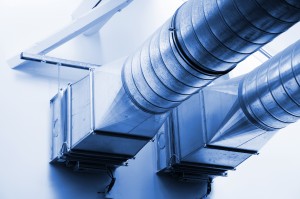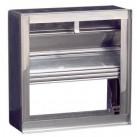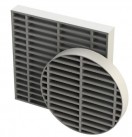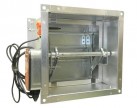Fire safety requirements are one of the areas included under HTM 03-01 testing. Fire dampers are installed to prevent the spread of fire where air ducts pass through fire resistant barriers. Typically smoke dampers are designed to prevent the flow of smoke and products of combustion and are able to withstand high differential pressures.
 Statistics show that an average of 50 fires occur daily in non-domestic UK buildings. Fire dampers are hidden from building occupants and generally from the owner and operational team, however they play an essential role in fire and smoke protection. It is essential therefore that they are subject to regular inspection and fire damper testing.
Statistics show that an average of 50 fires occur daily in non-domestic UK buildings. Fire dampers are hidden from building occupants and generally from the owner and operational team, however they play an essential role in fire and smoke protection. It is essential therefore that they are subject to regular inspection and fire damper testing.
A typical hospital will have in excess of 400 installed fire dampers. Our experience has shown that at least 15% are defective and require some form of remedial action.
Tecomak Environmental Services is an audited member of The Building and Engineering Services Association (B&ES). The B&ES publication DW/145 ‘Guide to Good Practice for the Installation of Fire and Smoke Dampers’ is widely used in the industry as a reference document.
Tecomak’s Fire Damper Inspection & Testing Service:
The service we offer hospitals has been tailored to suit the healthcare environment, the requirements of HTM 05-02 and HTM 03-01 validation and common challenges with access restrictions and possible lack of previous documentation.
Our standard service includes the following;
- Replacement of fusible links during inspection
- Out of hours working where required
- Issue of a comprehensive asset inventory
- Photographic record for each damper inspected
- Red lining of ductwork layout drawings
- Recommendations for remedial action
- Quotation for rectification works (if requested)
Requirements of HTM 03-01
In Part B of Health Technical Memorandum 03-01 the following guidance is given for HTM 03-01 testing:
| Section 1.3.1: | Regular tests, at intervals agreed with the local fire prevention officer, will need to be carried out in order to demonstrate the continuing efficiency of the fire detection and containment systems. These may be in addition to the inspections detailed above. Records of these tests should be kept. |
| Section 4.1.3: | All fire dampers should be tested as part of the annual verification. |
HTM 05-02: Fire Code
HTM 05-02 was updated in 2014 and the latest version ‘Guidance in support of functional provisions (Fire safety in the design of healthcare premises) has been revised to reflect changes in legislation, guidance and structure of the NHS. HTM 05-02 is written to allow the current statutory regulations to be applied sensibly within a frame work of understanding to satisfy all the requirements of Part B of Schedule 1 of the 2010 Building Regulations.
British Standard 9999:2008
British Standard 9999:2008 “Code of Practice for Fire Safety in the Design, Management & Use of Buildings’ defines a Fire Damper as a “mechanical device that is operated automatically or manually and is designed to prevent the passage of fire and which, together with its frame, is capable of meeting for a stated period of time the fire resistance criterion for integrity”.
BS 9999:2008 states ‘any grille or opening through the enclosure for ventilation purposes should be protected by a fire damper”
Fire dampers are located where ductwork passes through fire compartment walls and floors. They are typically held open by a ‘fusible link’ which BS 9999:2008 defines as a “device that releases a component such as a fire damper or fire shutter at a set temperature”.
Main Types of Fire Damper
 Curtain fire dampers are constructed using a series of interlocking blades, which fold to the top and are held open by means of a thermal release mechanism. The mechanism may be activated electronically or by a mechanical spring at around 72°C.
Curtain fire dampers are constructed using a series of interlocking blades, which fold to the top and are held open by means of a thermal release mechanism. The mechanism may be activated electronically or by a mechanical spring at around 72°C.
 Intumescent fire resisting dampers are constructed using components that expand when heated by a fire, activating typically in the range 120°C to 270°C. Some designs incorporate electromechanical devices to provide cold smoke containment by means of external control.
Intumescent fire resisting dampers are constructed using components that expand when heated by a fire, activating typically in the range 120°C to 270°C. Some designs incorporate electromechanical devices to provide cold smoke containment by means of external control.
 Single and multi-blade fire dampers have one or more linked framed pivoting blades, released by a thermal release mechanism at around 72°C, again either by a mechanical spring or by means of external control.
Single and multi-blade fire dampers have one or more linked framed pivoting blades, released by a thermal release mechanism at around 72°C, again either by a mechanical spring or by means of external control.
Further Information:







